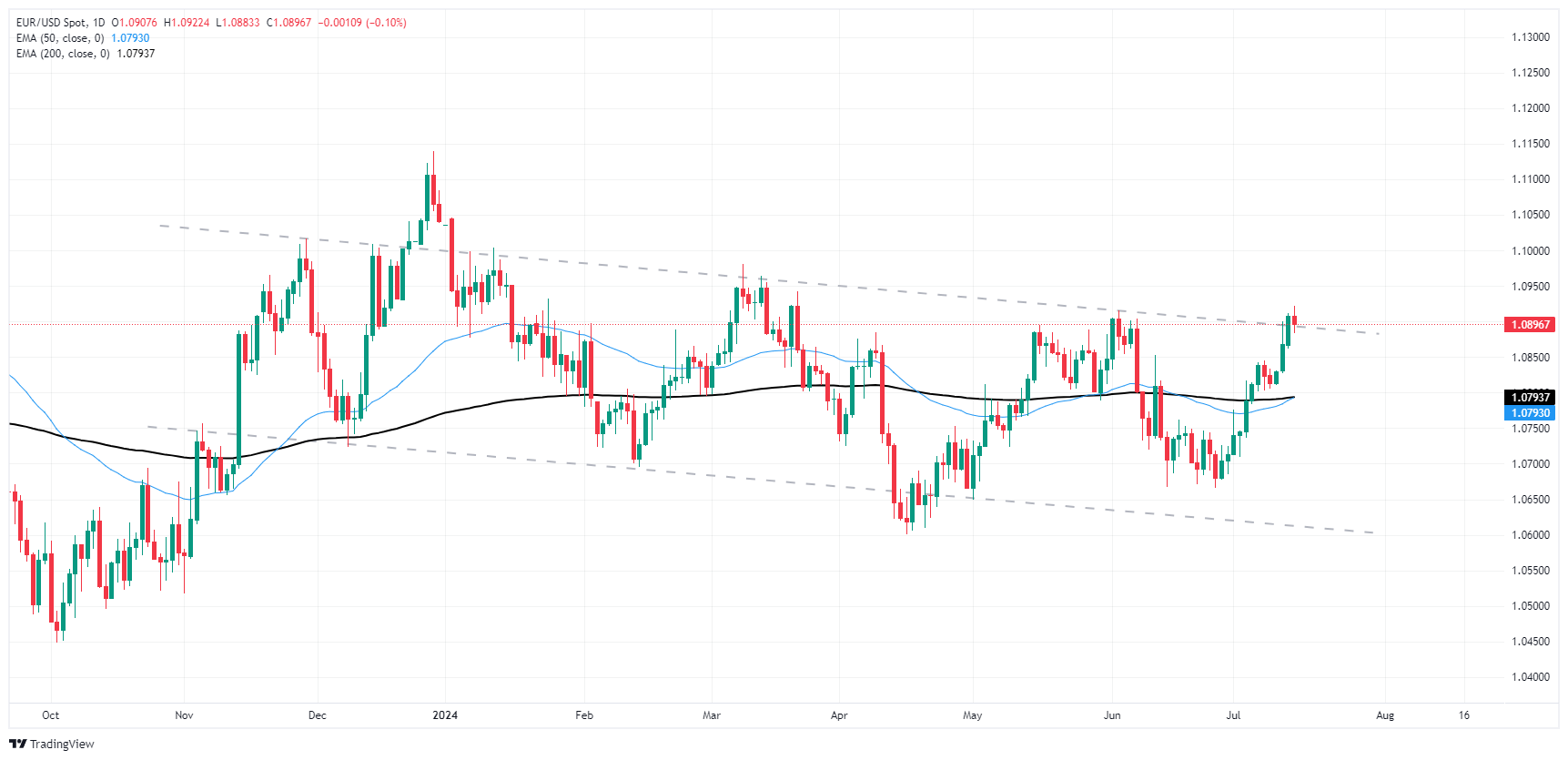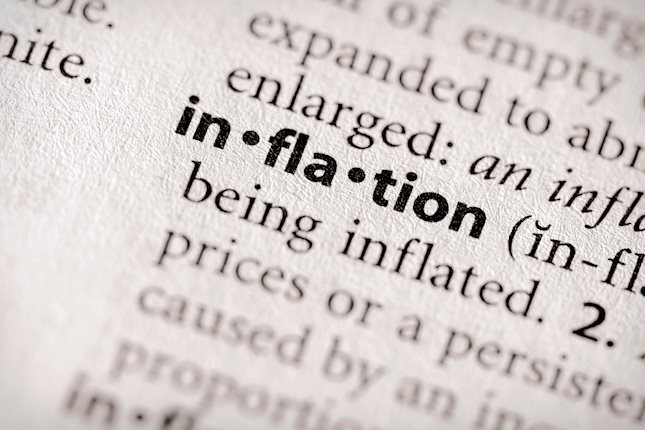- EUR/USD bidders failed to make a clean break of 1.0900 on Monday.
- Fiber’s near-term bull run set to end as technicals weigh heavily on buyers.
- ECB rate call due in the back half of the week to constrain Euro bids.
EUR/USD fell short of recent bullish momentum, pulling back sharply after a brief jump above 1.0900 to kick off the new trading week and keeping price action strung out along the top end of a descending price channel. Traders are weighing their stance on the Greenback as Fedspeak dominated investor sentiment with appearances from key policymakers on Monday.
Forex Today: Markets’ attention shifts to data and Fedspeak
Federal Reserve Chairman Jerome Powell acknowledged the recent progress on inflation on Monday. He was followed by a less important statement from San Francisco Fed President Mary Daly. Both key Fed policymakers emphasized that there is no fixed guidance on when Fed rate cuts will happen and that decisions will be made on a meeting-by-meeting basis.
Read more:
Fed's Powell: Decisions to be made on a meeting-by-meeting basis
Fed's Daly: Confidence is growing that inflation is heading lower
According to the CME’s FedWatch Tool, the market is expecting a rate cut in September. Rate traders are now pricing in a 100% chance that the Fed funds rate will decline by at least 25 basis points when the Federal Open Market Committee (FOMC) meets on September 18.
The upcoming US Retail Sales data release on Tuesday will conclude the recent series of important US economic data releases. It is anticipated that there will be a continued slowdown in US economic activity, with US Retail Sales expected to remain unchanged at 0.0% month-over-month in June.
Euro traders will be buckling down for the wait to Thursday’s latest rate call from the European Central Bank (ECB). A follow-up rate cut to June’s quarter-point trim is anticipated, but not expected until September with a third 2024 rate cut penciled in for December. As noted by Pimco Executive Vice President and Portfolio Manager, Konstantin Veit pointed out that “the ECB has clearly signalled its preference to make interest rate decisions at forecast meetings, i.e. in September and December, and not in July, October or January".
EUR/USD technical outlook
Despite tipping into a fresh 16-week high on Monday, EUR/USD flubbed a challenge of the 1.0900 handle, easing back and leaving daily candlesticks mired in technical consolidation at the top end of a rough descending channel. Fiber ended a three-day winning streak, and is poised to tumble out of a bullish stance that dragged bids into the green for all but two of the last 12 consecutive trading days.
EUR/USD daily chart
Euro FAQs
The Euro is the currency for the 20 European Union countries that belong to the Eurozone. It is the second most heavily traded currency in the world behind the US Dollar. In 2022, it accounted for 31% of all foreign exchange transactions, with an average daily turnover of over $2.2 trillion a day. EUR/USD is the most heavily traded currency pair in the world, accounting for an estimated 30% off all transactions, followed by EUR/JPY (4%), EUR/GBP (3%) and EUR/AUD (2%).
The European Central Bank (ECB) in Frankfurt, Germany, is the reserve bank for the Eurozone. The ECB sets interest rates and manages monetary policy. The ECB’s primary mandate is to maintain price stability, which means either controlling inflation or stimulating growth. Its primary tool is the raising or lowering of interest rates. Relatively high interest rates – or the expectation of higher rates – will usually benefit the Euro and vice versa. The ECB Governing Council makes monetary policy decisions at meetings held eight times a year. Decisions are made by heads of the Eurozone national banks and six permanent members, including the President of the ECB, Christine Lagarde.
Eurozone inflation data, measured by the Harmonized Index of Consumer Prices (HICP), is an important econometric for the Euro. If inflation rises more than expected, especially if above the ECB’s 2% target, it obliges the ECB to raise interest rates to bring it back under control. Relatively high interest rates compared to its counterparts will usually benefit the Euro, as it makes the region more attractive as a place for global investors to park their money.
Data releases gauge the health of the economy and can impact on the Euro. Indicators such as GDP, Manufacturing and Services PMIs, employment, and consumer sentiment surveys can all influence the direction of the single currency. A strong economy is good for the Euro. Not only does it attract more foreign investment but it may encourage the ECB to put up interest rates, which will directly strengthen the Euro. Otherwise, if economic data is weak, the Euro is likely to fall. Economic data for the four largest economies in the euro area (Germany, France, Italy and Spain) are especially significant, as they account for 75% of the Eurozone’s economy.
Another significant data release for the Euro is the Trade Balance. This indicator measures the difference between what a country earns from its exports and what it spends on imports over a given period. If a country produces highly sought after exports then its currency will gain in value purely from the extra demand created from foreign buyers seeking to purchase these goods. Therefore, a positive net Trade Balance strengthens a currency and vice versa for a negative balance.
Information on these pages contains forward-looking statements that involve risks and uncertainties. Markets and instruments profiled on this page are for informational purposes only and should not in any way come across as a recommendation to buy or sell in these assets. You should do your own thorough research before making any investment decisions. FXStreet does not in any way guarantee that this information is free from mistakes, errors, or material misstatements. It also does not guarantee that this information is of a timely nature. Investing in Open Markets involves a great deal of risk, including the loss of all or a portion of your investment, as well as emotional distress. All risks, losses and costs associated with investing, including total loss of principal, are your responsibility. The views and opinions expressed in this article are those of the authors and do not necessarily reflect the official policy or position of FXStreet nor its advertisers. The author will not be held responsible for information that is found at the end of links posted on this page.
If not otherwise explicitly mentioned in the body of the article, at the time of writing, the author has no position in any stock mentioned in this article and no business relationship with any company mentioned. The author has not received compensation for writing this article, other than from FXStreet.
FXStreet and the author do not provide personalized recommendations. The author makes no representations as to the accuracy, completeness, or suitability of this information. FXStreet and the author will not be liable for any errors, omissions or any losses, injuries or damages arising from this information and its display or use. Errors and omissions excepted.
The author and FXStreet are not registered investment advisors and nothing in this article is intended to be investment advice.
Recommended content
Editors’ Picks

EUR/USD trades deep in red below 1.0300 after strong US jobs report
EUR/USD stays under bearish pressure and trades below 1.0300 in the American session on Friday. The US Dollar benefits from the upbeat jobs report, which showed an increase of 256,000 in Nonfarm Payrolls, and forces the pair to stay on the back foot heading into the weekend.

GBP/USD drops toward 1.2200 on broad USD demand
GBP/USD extends its weekly slide and trades at its weakest level since November 2023 below 1.2250. The data from the US showed that Nonfarm Payrolls rose by 256,000 in December, fuelling a US Dollar rally and weighing on the pair.

Gold ignores upbeat US data, approaches $2,700
Following a drop toward $2,660 with the immediate reaction to strong US employment data for December, Gold regained its traction and climbed towards $2,700. The risk-averse market atmosphere seems to be supporting XAU/USD despite renewed USD strength.

Sui bulls eyes for a new all-time high of $6.35
Sui price recovers most of its weekly losses and trades around $5.06 at the time of writing on Friday. On-chain metrics hint at a rally ahead as SUI’s long-to-short ratio reaches the highest level in over a month, and open interest is also rising.

Think ahead: Mixed inflation data
Core CPI data from the US next week could ease concerns about prolonged elevated inflation while in Central and Eastern Europe, inflation readings look set to remain high.

Best Forex Brokers with Low Spreads
VERIFIED Low spreads are crucial for reducing trading costs. Explore top Forex brokers offering competitive spreads and high leverage. Compare options for EUR/USD, GBP/USD, USD/JPY, and Gold.